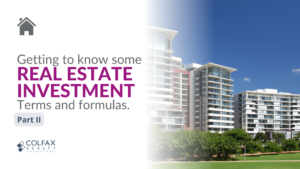
Rent-to-own (RTO): Rent-to-own is a combination of a lease and purchase agreement. With an RTO, the tenant’s monthly payment to the landlord is divided so that a portion goes toward the monthly rent and the remainder goes toward the purchase price of the home as stated in the contract. (It is also sometimes referred to as a lease with an option to purchase).
Real Estate Owned (REO): An REO property is one that has been foreclosed on by a bank that held the mortgage and is now owned by that bank. REO properties are often resold below market value.
Retail Investors: Retail investors are individual or small investors who invest in properties for their personal accounts, as opposed to institutional investors, who generally invest significantly larger amounts on behalf of institutions, e.g., fund managers or private equity firms.
Net Operating Income (NOI): Net Operating Income (NOI) is the gross profit from a rental property. It is calculated as gross rents, all non-interest expenses.
Mortgage Insurance Premium (MIP): To minimize the risk to a lender, if you are purchasing a property with a down payment of less than 20%, you should purchase mortgage insurance. The type of insurance you will pay for will depend on the type of loan you have. For a conventional loan, you will have PMI (private mortgage insurance) and for an FHA loan, you will have MIP.
Projected Annual Appreciation: This is a projection of the potential increase in value for the property typically based on 3rd party valuation tools.
Section 8: A federal government housing program that allows low-income families and the disabled and elderly to rent housing in the private market based on eligibility criteria such as income and family size.
Self-Directed IRA (SDIRA): A self-directed IRA or retirement account is similar to a traditional IRA with one key difference: in addition to stocks and bonds, an SDIRA can also be used to invest in the real estate industry. All returns from this type of investment are tax-deferred and must be deposited back into the IRA.
Turnkey Property (also turnkey): A rental-ready property, i.e., an investment property that requires no repairs or renovations to rent to tenants and is upgraded to current market standards.
Balloon Mortgage: A balloon mortgage is a secondary type of seller financing. The buyer agrees to take over the existing mortgage and adds the amount of money on top of it, usually the new purchase price. The wraparound mortgage becomes a second or third mortgage on the same property. It is also known in the industry as a retroactive mortgage or a wraparound loan.
Conociendo algunos términos y fórmulas de la inversión inmobiliaria. Parte II.
Alquiler con opción a compra (RTO): El alquiler con opción a compra es una combinación de un contrato de alquiler y compra. Con un RTO, el pago mensual del inquilino al propietario se divide de manera que una parte se destina al alquiler mensual y el resto al precio de compra de la casa según lo establecido en el contrato. (A veces también se denomina arrendamiento con opción a compra).
Bienes inmuebles en propiedad (REO): una propiedad REO es una que ha sido embargada por un banco que tenía la hipoteca y que ahora es propiedad de ese banco. Las propiedades REO a menudo se revenden por debajo del valor de mercado.
Inversionistas minoristas: los inversionistas minoristas son inversionistas individuales o pequeños que invierten en propiedades para sus cuentas personales, a diferencia de los inversionistas institucionales, que generalmente invierten cantidades significativamente mayores en nombre de instituciones, por ejemplo, administradores de fondos o firmas de capital privado.
Ingreso operativo neto (NOI): El ingreso operativo neto (NOI) es la ganancia bruta de una propiedad de alquiler. Se calcula como alquileres brutos, todos los gastos que no sean intereses.
Prima de seguro hipotecario (MIP): para minimizar el riesgo para un prestamista, si está comprando una propiedad con un pago inicial inferior al 20%, deberá contratar un seguro hipotecario. El tipo de seguro que pagará dependerá del tipo de préstamo que tenga. Para un préstamo convencional, tendrá PMI (seguro hipotecario privado) y para un préstamo FHA, tendrá MIP.
Projected Annual Appreciation: This is a projection of the potential increase in value for the property typically based on 3rd party valuation tools.
Sección 8: Un programa de vivienda del gobierno federal que permite que las familias de bajos ingresos y las personas discapacitadas y de la tercera edad alquilen viviendas en el mercado privado en función de criterios de elegibilidad como los ingresos y el tamaño de la familia.
IRA autodirigida (SDIRA): una IRA autodirigida o cuenta de jubilación es similar a una IRA tradicional con una diferencia clave: además de acciones y bonos, una SDIRA también se puede usar para invertir en la industria de bienes raíces. Todos los rendimientos de este tipo de inversión tienen impuestos diferidos y deben volver a depositarse en la cuenta IRA.
Propiedad llave en mano (también llave en mano): una propiedad lista para alquilar, es decir, una propiedad de inversión que no requiere reparaciones ni renovaciones para alquilar a los inquilinos y se actualiza según los estándares actuales del mercado.
Hipoteca integral: una hipoteca integral es un tipo secundario de financiamiento otorgado por el vendedor. El comprador acepta hacerse cargo de la hipoteca existente y agrega la cantidad de dinero encima, generalmente el nuevo precio de compra. La hipoteca envolvente se convierte en una segunda o tercera hipoteca sobre la misma propiedad. También se conoce en la industria como una hipoteca retroactiva o un préstamo envolvente.

Leave a Reply